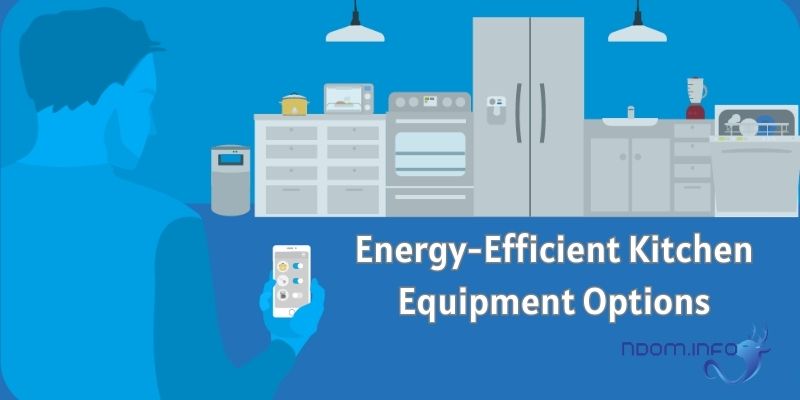Understanding the Concept of Kitchen Sustainability
In today’s world, sustainability has become a vital part of everyday life, and our kitchens are no exception. As the importance of environmental conservation and energy consumption grows, households are seeking ways to reduce their ecological footprint and embrace more eco-friendly practices. Energy-efficient kitchen equipment options provide an excellent solution to this challenge, allowing homeowners to create environmentally conscious kitchens while saving on energy costs. In this article, we will delve into the realm of modern kitchen sustainability, exploring the significance of energy-efficient kitchen equipment options, their benefits, and practical steps to implement a sustainable kitchen.
The Significance of Energy-Efficient Kitchen Equipment
Energy-efficient kitchen equipment lies at the core of modern kitchen sustainability. These appliances are designed to minimize energy consumption while still delivering excellent functionality and performance. By choosing energy-efficient kitchen equipment, homeowners contribute to reducing greenhouse gas emissions and overall energy demand, supporting a more sustainable future.
Various Categories of Energy-Efficient Kitchen Equipment

Energy-efficient equipment spans different categories within the kitchen space:
-
Refrigeration: Energy-efficient refrigerators play a crucial role in creating a green kitchen. Look for refrigerators with high Energy Star ratings, as they use significantly less electricity than conventional models. Additionally, advanced smart refrigeration technologies offer features such as optimal temperature control, adaptive defrosting, and energy-saving modes.
-
Cooking Appliances: Induction cooktops are one of the most energy-efficient cooking solutions available. They use electromagnetic technology to heat only the cookware, minimizing energy waste. Similarly, energy-saving ovens and stoves employ advanced insulation and efficient heating elements to reduce energy consumption during cooking.
-
Dishwashers: Investing in water-saving and energy-efficient dishwashers can have a significant impact on overall energy use in the kitchen. Look for models with intelligent sensors that adjust water and energy consumption based on the load size and level of soil.
-
Lighting: Switching to energy-efficient lighting options, such as LED bulbs, significantly reduces electricity usage. LED lights are long-lasting, consume less power, and emit minimal heat, making them an ideal choice for both the kitchen and the environment. Smart lighting solutions allow homeowners to control lighting remotely and set schedules for optimal energy use.
Top Energy-Efficient Kitchen Appliances

Energy Star certification serves as a reliable marker of energy efficiency in kitchen appliances. When selecting energy-efficient equipment, consider the following:
-
Refrigeration: Energy-efficient refrigerators not only reduce energy consumption but also help preserve food for longer periods, minimizing food waste. Look for models with advanced temperature control and humidity features to keep food fresh while saving energy.
-
Cooking Appliances: Induction cooktops utilize electromagnetic induction to directly heat the cookware, resulting in faster cooking times and less wasted heat. Moreover, energy-efficient ovens with convection technology distribute heat more evenly, reducing cooking time and energy consumption.
-
Dishwashers: Energy-efficient dishwashers often come equipped with soil sensors, efficient spray nozzles, and low-energy drying options. These features help optimize water and energy use, providing a greener way to clean dishes.
-
Lighting: LED lighting not only reduces energy consumption but also emits less heat, keeping the kitchen cooler during hot weather. Additionally, smart lighting systems enable users to control the brightness and timing, further optimizing energy usage.
Best Practices for Energy Conservation in the Kitchen

Beyond investing in energy-efficient kitchen equipment, there are several best practices that homeowners can adopt to conserve energy in the kitchen:
-
Efficient Cooking and Meal Preparation: Use lids while cooking to retain heat and reduce cooking times. Optimize oven and stovetop usage by cooking multiple dishes simultaneously. Consider batch cooking and freezing leftovers for convenient, energy-saving meals.
-
Proper Maintenance of Kitchen Appliances: Regularly clean and maintain kitchen appliances to ensure they operate at peak efficiency. Clean the refrigerator coils, oven burners, and dishwasher filters to prevent energy waste due to dust and debris buildup.
-
Smart Kitchen Management and Automation: Utilize smart home technology to monitor and control kitchen appliances remotely. Smart thermostats can optimize the refrigerator and freezer temperatures, while smart plugs can manage the on/off cycles of small appliances.
-
Reducing Food Waste: Minimize food waste by planning meals, storing perishables properly, and composting food scraps. Discarded food not only wastes resources but also contributes to unnecessary energy consumption during production and transportation.
Overcoming Challenges in Adopting Sustainable Kitchen Practices
While embracing energy-efficient kitchen equipment options and sustainable practices may initially seem daunting, it is essential to address common challenges to achieve long-term success:
-
Initial Investment and Cost Considerations: While energy-efficient appliances may have higher upfront costs, the long-term energy savings and environmental benefits outweigh the initial investment. Homeowners should consider these appliances as an investment in a greener future.
-
Educating and Motivating Household Members: Creating a sustainable kitchen requires the support and understanding of all household members. Educate family members about the benefits of energy efficiency and involve them in the decision-making process to foster commitment and enthusiasm.
-
Addressing Potential Limitations and Misconceptions: Some homeowners may have concerns about the performance or features of energy-efficient appliances. Research and consult with experts to dispel misconceptions and find equipment that meets specific needs and preferences without sacrificing energy efficiency.
Case Studies: Real-Life Examples of Energy-Efficient Kitchens
To gain insight into the tangible benefits of energy-efficient kitchen equipment and sustainable practices, let’s explore a few real-life examples:
Case Study 1: The Johnson Family – The Johnsons transformed their kitchen into an energy-efficient haven by investing in Energy Star-certified appliances and LED lighting. Their electricity bills reduced by 30%, and they noticed a considerable decrease in food waste due to better temperature and humidity control in their refrigerator.
Case Study 2: The Smiths’ Smart Kitchen – The Smiths integrated smart kitchen technology, including a smart dishwasher and lighting system, into their home. By using voice commands and automated schedules, they optimized energy use in their kitchen, leading to noticeable savings on their energy bills.
Conclusion: Creating a Sustainable Future
Embracing energy-efficient kitchen equipment options and sustainable practices is no longer just a trend; it is a necessity for a greener, more environmentally responsible future. Energy-efficient appliances, combined with smart kitchen management and responsible usage, can significantly reduce energy consumption and promote a sustainable lifestyle. By making informed choices and committing to change, homeowners can create modern, energy-efficient kitchens that not only benefit their wallets but also contribute to the global effort to preserve our planet for future generations. Let’s each play our part in building a sustainable world, starting with the heart of our homes – the kitchen.

